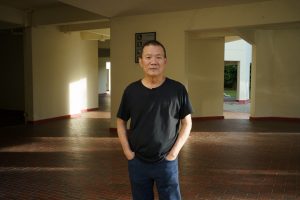“Sakit,” groans the old man lying in a hospital bed covered in bright floral bed sheets, wincing in pain.
“Bapa tenang. Don’t worry,” his daughter whispers, her head bowed. Her body is crouched next to her father’s, one hand caressing his forehead and another lightly squeezing his hands.
ADVERTISEMENT
“Your children are here. We will always be with you,” her voice breaks as she turns her head away and reaches out for some lavender oil on the bedside table. She tenderly massages the oil over his temples, now cold like a sheet of ice.
“Remember to istighfar, bapa,” she repeats in hushed tunes, fading into the lull of the Quranic verses playing in the background—an audible reminder of God in his last moments.
This is the picture Puan Intan paints for me as she explained the importance of palliative care in the context of death.
“This is the moment where you’ll really need help, and to have someone you love by your side,” she draws a sharp breath, “it’s an intimate moment you wouldn’t want to miss. Everything you’ve done before leads up to this moment.”
Puan Intan’s phone begins buzzing, a norm for her as the current Operations Manager for Pengurusan Jenazah Sinaran Baharu (PJSB), a Muslim funeral home.
“In PJSB, we don’t only handle funerals but we also have our own ambulance services and conduct classes for the community. In particular, PJSB conducts palliative care classes for individuals who are tasked to be caregivers to a loved one.”
Defining palliative care
The International Association for Hospice and Palliative Care (IAHPC) defines palliative care as the “active holistic care of individuals across all ages with serious health-related suffering due to severe illness, and especially of those near the end of life. It aims to improve the quality of life of patients, their families, and their caregivers.”
But to Puan Intan, palliative care is comfort management.
“When the doctor announces: ‘Okay, I think it’s time you bring your loved one home’, there’s nothing else that the family can do. They have to start asking themselves, what do they need to know, what things do they have to prepare for the return of a sick family member, all these things, you know?”
“Palliative care is the special care given to patients with chronic illnesses because you know they may pass away anytime now,” adds the operations manager. “It’s quality nursing care. Not just giving medication, turning, or cleaning them. Those are the basics. Palliative care is more comprehensive, especially in terms of how you handle the patient. How do you talk to them? When they’re in pain, how do you console them? And when they’re in pain, they also get very emotional, so what do you do? These are the important parts of palliative care.”
The World Health Organization (WHO) outlines how palliative care covers a wide range of diseases from chronic diseases such as “cardiovascular diseases, cancer, chronic respiratory diseases, AIDS, and diabetes” as well as “Parkinson’s disease, rheumatoid arthritis, neurological disease, dementia, congenital anomalies, and drug-resistant tuberculosis.”
After 32 years in nursing, Puan Intan became a private family nurse to a dementia patient. Her experience as a private nurse helped her better understand such intensive care for patients and encouraged her to join palliative care. Currently, she focuses primarily on end-of-life care.
“For me, it’s important to keep in mind how we want to take care of someone who is already going? How can we best serve them in their last days?”
Who should care?
In essence, all Singaporeans. But particularly the youths of this country.
According to Statista, Singapore is projected as the ASEAN country with the largest share of population above 65 years in 2035 (32%). Currently, 229.4 thousand Singaporeans are between the ages of 65 to 69 years old alone and approximately 311.7 thousand between 45-49, making it the largest age group among its resident population. It also reflects an increasingly ageing population in Singapore with an old-age dependency ratio of 21.6 (per hundred residents in the working-age of 15-64 years).
If these numbers are confusing you, suffice to say the growing push for more elder-friendly residences like the Bukit Batok community care apartments (CCAs) or prevalence of Senior Activity Centres was not done in vain. Singapore has an ageing population, and it’s beginning to show.
With our life expectancy capped at 83.9 years in 2020, it seems very likely that younger Singaporeans, be it Gen Z or Millennials, have many more years of caring for their parents ahead. And it won’t be easy either.
In 2017, 37% of respondents in a survey by Singapore General Hospital reported three or more chronic health conditions. This means that not only will we be spending more years with Mom and Dad, but we’re also likely to ferry them for multiple medical appointments, ensuring that they’re getting their medication and are taken care of.
ADVERTISEMENT
And this is looking on the brighter side of things
If their condition exacerbates, we may even have to face the real possibility of preparing for their departure. And that brings its own set of obstacles from expensive medical bills to grappling with the emotional turmoil that ensues.
The nitty-gritty details of an ageing population sound daunting, making it easy to forget that behind all these statistics and concerns are elderly folks dealing with serious ailments that are affecting the way they live. And as much as they’d like to admit that they can manage themselves, they really could use some help.
The role of family
“A caregiver could be a nurse, a domestic helper, or a family member,” elaborates Puan Intan. “In fact, if you train a domestic helper, they can be a really good caregiver too. As long as it is someone who can be with the patient 24/7.”
‘Care’ need not have a fixed persona attached to it but the niche skills required of palliative care must be acknowledged.
“If you have a medical background, it tends to be easier. But if you don’t, you should still learn the basics. Things like how to change a diaper or manage bedsores. For instance, if the patient is bedridden, things like 2-hourly turning become essential.”
In PJSB, she helps organise palliative care classes for caregivers to learn the ropes, with live demonstrations for participants to better grasp these medical skills and techniques.
“But no matter what, ideally, the family should do it. Palliative care involves a lot of emotional effort. It ranges from reading the patient’s body language to knowing what they want or what they are trying to tell us, whether they’re in pain or uncomfortable. And it also involves becoming more in tune with their emotional needs as we take note of how to comfort them in these unpleasant moments.”
Palliative care requires empathy that may transcend the usual patient-nurse relationship. And it definitely isn’t a role that should be taken up solely on a transactional basis.

On intentions
“If you work for the money, you will only get money.”
Puan Intan notes that such an attitude won’t yield any satisfaction for the caregiver. Even the patients can discern when there’s a lack of sincerity.
ADVERTISEMENT
“It’s in the vibes,” she jokes. “You can tell when it’s not ikhlas (sincere).”
She shares the perspective of the patients, emphasising that all they want is to be surrounded by people who are genuinely concerned about their well-being.
“They don’t want to be a burden. So sure, you can do the job just for the sake of it but it shows in your face and attitude.”
Even though these actions may hurt the patient, she notes how they tend to stay silent because they are already cognizant of the strain they are putting on their loved ones. Instead of giving their family more trouble, they choose to be quiet.
“You do what you want lah,” Puan Intan mimics a patient’s inner thoughts.
But sometimes even the money isn’t enough. The work is hard, as Puan Intan has stressed, and it tends to take a toll on the caregivers.
“Family members must be prepared physically, mentally, and emotionally,” Puan Intan reiterated.
Talking about death to your loved ones is difficult as it is but being a caregiver is not only challenging but intensive. It is much more emotional than nursing in a ward because patients are usually in a sensitive state, both physically and emotionally. Moreover, ward nurses in Singapore work on a shift basis, but a caregiver is almost always on duty, especially if it is a family member.
The emotional and mental toll as well as the possible aversion that come with handling things like faeces and blood makes palliative care a demanding role for any person to take up.
“But let me tell you Laili, when we have the heart to do it, even the hardest things become easier. It’s all in the mind. We might feel grossed or burnt out, but we should try to realign our intentions. Remember who it is we’re caring for,” Puan Intan briefly tapped her temples as she shared this reminder.
What if no one in the family wants to do it?
“You send them to the hospice,” she teases wryly.
In such unfortunate circumstances, the hospital will typically make arrangements with the family and medical social worker regarding their plans for the subsequent outpatient care. When hospitals can no longer house the patients in their wards, they will interview the family and ask them if they have any difficulties bringing the patient back home, and why.
“Usually we know what’s happening ah. Most of the time they just tai chi to one another. No one is willing to do it so they just come up with all sorts of excuses and stories.”
Regardless, there’s no other option once the patient is discharged. It’s either done by the family, private nurses, or maids. But the hospital never releases a patient if the family isn’t ready.
Gearing up for palliative care
“When the patient is already diagnosed with a chronic illness, the family should be discussing who should take on the role of a caregiver. Or at least, when the patient is in a critical state.”
Puan Intan reminds me of all the logistics that should already be prepared such as diapers and home equipment. She also points out how we can ask a nurse to come down and train a family member to provide palliative care, especially in terms of nursing.
“It would be useful if the family cooperates. One person can financially provide and chip in for the medical bills. Another can provide help with nursing.”
But whoever becomes the caregiver needs to be mentally prepared, if not they may experience burnout. The caregivers might develop feelings of frustration stemming from this burnout which can unfold in their interactions with the family. Such tension brimming in the household could easily transform into arguments where one is likely to unintentionally pass harsh remarks about the patient’s condition.
“If you need to say something, don’t say it in front of the patient. Remember, they can still hear you.”
She shares some examples of things caregivers might say and explains how it may hurt the patients to hear how they are imposing on their families. Things like “She’s getting so difficult these days” or “I’m tired of taking care of Dad” are remarks that may be embedded in patients’ minds.
Puan Intan tells me how patients may feel worse upon hearing these things. They may constantly worry about how they are bothering their family and their condition may even further deteriorate due to such anxieties.
“Sometimes we can’t tell how long palliative care may last. It could be for one day or it could be much longer. And it can get tiring, so it’s important to alert the rest of your family when you need help.”
Ultimately, based on what Puan Intan has shared, palliative care is not something that one can pick up on the spot. Unlike learning how to play the guitar or a new TikTok dance, palliative care is a life skill that we should take pains to be familiar with at a younger age. It is a skill much like first-aid or CPR—we never know when we might need it but we should always be ready to use it.

Unpacking the nonchalance
Strangely, many youths may have received a first-aid certification but not all of us are familiar with palliative care.
I asked Puan Intan why the nonchalance regarding this important life skill and her answer was simple: “Because we take it for granted.”
She added: “When our parents are still healthy and when we haven’t had to witness loved ones suffering through such illnesses, it’s easier to ignore things like palliative care.”
Yet, she points out the flaw in such mindsets—it’s short-term thinking.
“We know our parents are getting older and people tend to have more illnesses when you do so. So youngsters should start learning about palliative care before they even need the skills. It’s the kind of knowledge you can’t buy. Also, it’s better to nurse a patient at home. When they are at the end of their lives and there’s not much left for the hospital to do, it’s best to just bring them home.”
With this pandemic that we’re in and with reports of the recent new clusters in nursing homes, it may actually be safer to nurse family members at home, should the need arise.
As Puan Intan repeatedly articulates the comfort that comes from passing away at home, we may remember certain family members who also explicitly request to be brought home for their final days.
Perhaps, the cold surgical walls in the hospital seem more hostile as compared to dusty walls littered with familiar photos and beds with worn-out pillows. It feels like that the last thing one wants when approaching death is to be in a place that constantly reeks of it. Instead, people may prefer to spend their final moments in the place they filled most of their lives.
Honouring death
Just as we may seek comfort in a familiar space, we may also seek it in the persons surrounding us.
Think of the act of giving birth, the scene of a woman pushing the baby out and her husband doing his best to support her. The flock of nurses huddled around her, giving her advice, assistance, and everything necessary for smooth delivery.
People tend to glorify those moments, but perhaps it’s just as important to honour the converse. As much as we want this guarantee of total comfort and support at birth, the same could be said for death. After all, these are the stages of our lives where a person is at their most vulnerable.
“Palliative care is first and foremost for the patient,” states Puan Intan.
So more than the mother in labour or a child reassuring their father on his deathbed, comfort, and support should be prioritized for the individual born or the one who is dying.
“We should always prioritise the patient over the caregiver. That’s why the relationship between the two is so important,” she stresses.







